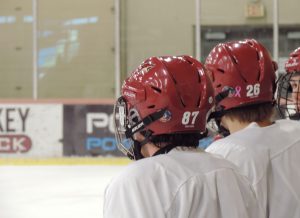- Slug: Sports-Hockey Neckguard. 790 words.
- Photo available.
By Josh Jones
Cronkite News
SCOTTSDALE – Hockey and its relationship with neck guards has been a point of debate among all levels of hockey for years, but it is now a reality in youth hockey.
USA Hockey established a mandate on Jan. 28 for all players 18 and under to wear neck guards beginning on Aug. 1. The discussion became a hot topic after the death of former NHL player Adam Johnson in the Elite Ice Hockey League on Oct. 28, when an opposing player collided with Johnson and struck his neck with his skate.
The tragedy triggered an influx of debate about requiring that neck guards be worn at all levels of hockey. Youth hockey understandably was at the forefront of conversation. There were 387,910 youth hockey players registered with USA Hockey in 2022-23.
The death of high school sophomore Teddy Balkind of St. Luke School in Connecticut in 2022, after a laceration to the neck, provided a tragic scare for the youth hockey community.
Lacerations and cuts may be a rare occurrence in comparison to other injuries such as concussions and broken bones, but they have been well documented by members of the hockey community.
“In 20-plus years of playing and coaching, I have seen players get cut many times.
It is very rare, it doesn’t happen every day, but I’ve seen wrists get stepped on and legs get cut between the shin guard and the skate,” said Marc Fritsche, tier program hockey director of the Jr. Coyotes. “In terms of cuts around the head and neck area, it’s a lot less prevalent. The skates have to come up that high, which happens from time to time, but it doesn’t happen regularly.”
The rarity of lacerations and cuts near the neck and face area has played a main role in the debate of whether a neck guard mandate is needed. However, with the two recent tragedies in the past two years, the safety concern has pushed USA Hockey to make a decision.
“The one thing that is consistent is that everybody has concern with the safety of the game,” said Dave Fischer, senior director of communications for USA Hockey. “As a parent myself, I have always appreciated (safety). It’s real and USA Hockey takes safety very seriously.”
Hockey players have always been selective with their equipment. Youth players have struggled with adjusting to wearing neck guards and realizing their importance. The father of a Jr. Coyotes 10U player, Brandon Richardson, shared a moment with his son’s teammate in a previous year.
“One of our teammates at the time just didn’t want to wear it,” Richardson said. “It was just new to him. It was uncomfortable so he was constantly fighting it. If it fell off then he wouldn’t fight to put it back on.”
The importance of safety over appearance has taken a stronger stance as of late. Youth players are starting to get more comfortable with wearing neck guards. Richardson said his son no longer even notices the neck guard.
“In fact, when he looks at the older players or the college players that wear them, he thinks it’s cool,” Richardson said.
The overall response to USA Hockey’s mandate has been positive. Parents, coaches and board members have all expressed their satisfaction with the neck guard rule.
“I think USA Hockey does the best job they can to make the game as safe as possible,” Fritsche said. “It’s hard to do. (The mandate) gives people more peace of mind. We want to keep our children as safe as possible and if it’s protecting their necks from getting cut. I’m all for it.”
“I’ll be happy to have (my son) wearing a neck guard in case he takes a slash or someone decides to take a stomp,” Richardson said.
With the mandate recently passed, the next question is whether there is enough access to proper equipment. The neck guards that are on the market currently have a wide variety of effectiveness. Some guards cover less skin than others and many of them are made with different materials. The focus is now on how to provide protection safely and effectively.
“The key is just to make sure that the product that they are wearing is effective and doing what it is designed to do,” Fritsche said.
Some guards gave examiners concerns that they could potentially deflect the skate blade and ultimately inflict more damage than the intended result of protection. The USA Hockey mandate has launched an effort to create a safer environment in hockey among other governing bodies. The Hockey Equipment Certification Council is currently working on certifying neck guards.
This certification would bring more peace of mind to parents and players and establish a consistent and safe protocol for neck guard protection moving forward.
For more stories from Cronkite News, visit cronkitenews.azpbs.org.
Links:
https://x.com/Shaun_Hansard/status/1718369071920464223?s=20
https://x.com/worldhockeyrpt/status/1718770298353271181?s=20
https://x.com/hbwknies/status/1718458260536098902?s=20
https://x.com/puckopossum/status/1718715420587245881?s=20
https://x.com/BlondeMAGAinNJ/status/1718727192090206677?s=20
